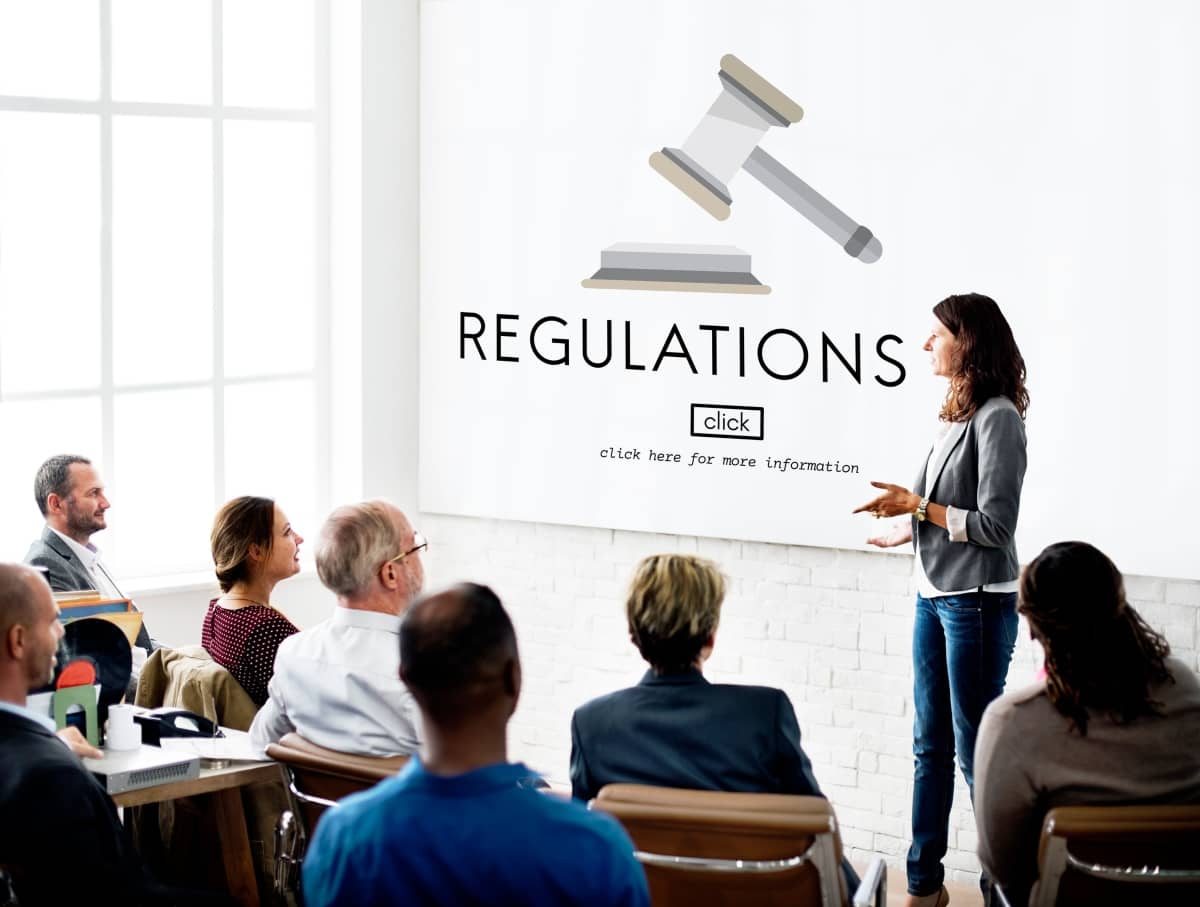Compliance Training in 2024 (How Not to Screw It Up & Lose $$)
Did you know compliance training has been around since the '90s?
But, we're living in an era where it's demanding more attention than ever before.
And — it's no longer optional.
No matter what industry you're in, it's likely you have government regulations influencing how you do business.
What happens if an organization fails to establish a compliance framework? It can find itself at risk of violation of federal law, financial penalty, a lawsuit, or in the worst-case scenario — dissolution.
Enter: Compliance training.
We'll explain what it is, the benefits of jumping on board, and how to put an effective program in place.
Let's dive right in.
What is Compliance Training?

Compliance training helps to create awareness and bake compliance into your organizational culture.
But first, we need to distinguish between corporate and human resource compliance training programs.
What is the workplace compliance training definition?
Corporate training educates employees on company policies and governmental laws that apply to their day-to-day job.
What is HR compliance training?
HR training typically focuses on anti-harassment, anti-discrimination, age, and job discrimination. But it also covers all laws complying with the US Department of Labor at a state and federal level.
These laws include:
- Consolidated Omnibus Budget Reconciliation Act (COBRA),
- Family Medical Leave Act (FMLA),
- Americans with Disabilities Act (ADA),
- Wages and Fair Labor Standards Act (FLSA),
- Occupational Safety and Health Administration Act (OSHA),
- Military leave,
- Equal Opportunity, and
- Payroll-related laws.
Good corporate compliance training shows that your organization is not only aware of applicable rules and laws.
But you're also taking genuine steps to stay on the right side of them.
Some Areas of Compliance Training
Compliance training leads to a better working environment that boosts productivity in the long run.
As your business evolves, you'll need to optimize your compliance training by ensuring it is continually updated for the following:
- New employees
- Additional training for employees transferring to new roles
- New technologies
- Business expansion
Why Compliance Training is Essential

The top dog of regulatory laws is OSHA, which states that an organization must provide safe working conditions for all employees.
Healthcare organizations must adhere to the Health Insurance Portability Act (HIPAA). This act details the expectations of healthcare professionals when handling protected health information.
Healthcare compliance training costs around $8.3 billion per year.
Does your organization handle online payments? Then, you must uphold the Payment Card Industry Data Security Standard (PCI DSS) or risk legal action.
At first glance, training may appear to detract from the more profitable aspects of running a business.
However, on average, organizations that encounter non-compliance problems pay out an average cost of $9.4 million. That's roughly three times higher than the cost of compliance.
This is why compliance training is so important. Without it, you're bound to violate something, whether you know it or not.
What is the cost of non-compliance?
Non-compliance occurs when organizations and employees fail to follow — or abuse — laws, rules, and regulations.
If your organization doesn't comply with regulations pertaining to your industry, you could risk the following:
- Sizable fines by the regulatory body,
- Customer lawsuits whose information you haven't protected,
- Market loss,
- Losing money and resources on risk mitigation, and
- Client loss after the incident is made public.
63% of organizations believe that their compliance program helps reduce legal costs, fines, and resolution time.
While organizations pay an average of $10,000 in regulatory costs annually per employee, non-compliance leads to over $5 million in business disruption losses, including operational disruptions.
Non-compliance can do some serious damage to an organization. In the worst-case scenario — destroy it. Who remembers the Enron scandal?
But, it's essential to look at the big picture and focus on the benefits that compliance training brings to the table.
What are the benefits of compliance training?
Often organizations will fail to recognize the many advantages of compliance training. Instead, they only concentrate on avoiding the consequences and penalties of non-compliance.

Good compliance training can show your staff how their actions can benefit or harm your organization, as well as create:
1. Employee engagement
Engaged employees are focused, productive and trustworthy custodians of corporate values. Compliance training promotes accountability, professional development, and provides staff with an incentive to engage.
Train your employees to nurture a culture of compliance. When employees feel they are acting ethically, they will feel more invested in your organization.
🤓Pro Tip! To really increase employee engagement, check out our top picks for employee engagement software!
2. A safer work environment
In 2019, work injuries cost businesses a staggering $171 billion.
Avoid becoming a statistic with practical compliance training. You'll not only help employees understand how you're creating a friendly, inclusive, and safe workplace. But it will also empower them to safely and correctly raise safety concerns or report issues within the organization.
3. Protect your organization's reputation
The damage caused by non-compliance could wind up affecting more than your bottom line. You can risk damaging your reputation, leading to losing potential clients and investors. Plus, you'll be subject to unwanted media attention.
Proactively commit to compliance, safety, and ethics. It will not only help to avoid any embarrassment or public scandal. But it can give you a competitive leg-up by attracting like-minded clients.
4. Reduced risk of litigation
What if a compliance issue or a lawsuit does arise? Your training records will indicate that your employees have current compliance certification.
Having these records on hand can help decrease your organization's liability, risk of litigation and lower the costs of any fines.
Types of Compliance Training
Staying up-to-date with compliance and regulation issues is a mammoth task, as the variation of compliance courses is immense.
Your industry, location, and activities all influence what employees need to be compliant in. And, in turn, what kind of training you need to deliver.
Some examples of regulatory compliance training subjects include:
1. Anti-harassment

Following the #MeToo movement in 2018, anti-harassment training stepped up its game. Despite this, employers still paid out a staggering $68.2 million for sexual harassment violations just one year later.
Anti-harassment training not only helps reduce gender bias in the workplace. It also puts measures in place for employees to handle workplace violence, sexual harassment, or bullying.
The training material must define harassment, provide behavioral examples, and include response strategies. You'll be creating an equal opportunity work culture, boosting morale, and promoting productivity.
Embrace a company policy that encourages witnesses to report bullying or harassment. Whether they have experienced it for themselves or not.
2. Diversity Training
Diversity training emphasizes more than the strengths of diversity. For example, employees learn to welcome co-workers of different sexual orientations, ethnicities, ages, and physical or mental abilities.
Training can also highlight how your organization portrays different demographics in marketing content and company documents.
3. Data Protection & Privacy and Cybersecurity
Online compliance training helps your staff distinguish between Personally Identifiable Information (PII) and Personal Data. And how cyber hackers may exploit this data.
On average, one data breach can cost an organization almost $4 million. To increase your organization's overall cybersecurity, it is recommended to use the most secure VPN.
Also, employee training must cover managing and protecting confidential information outside the work environment.
For example, employees need to understand how to handle data after hours when using their mobile devices and what to do if it's lost or stolen.
4. Business ethics
Organizations must be clear about their code of ethics and guidelines for disciplinary action. An Ethics and Compliance training program should include risk assessment and corruption. Plus, you'll need a system in place for dealing with any grey areas or conflicts of interest.
5. Whistleblower Protection

Whistleblower protection has been a fundamental topic in corporate compliance training in the US for many years.
Employees report 56% of initial complaints directly to their supervisors. For this reason, whistleblowers need to feel safe from retaliation. OSHA's whistleblower laws protect employees who raise concerns about workplace violations.
6. Workplace Health and Safety
Of course, some industries, jobs, and environments present more physical safety risks than others. But, all office settings must follow basic workplace safety standards.
Laws and regulations such as OSHA and The Joint Commission exist to protect workers from workplace hazards.
Safety training reduces risk, injury, and the threat to the health of your workers. It will also go a long way to boosting productivity and their confidence in your organization. Online safety training is also an option to make things even more convenient for your employees.
Implementation of Compliance Training
Implementing a corporate compliance training program bolsters an organization to do the right thing and protect it from risk.
A significant reason why compliance training fails is because of a poorly designed course.
Online learning (or eLearning) allows businesses to automate compliance training. eLearning not only eases the workload of compliance trainers. It also saves time and money and makes learning more engaging than the old pen and paper-based learning method.
Take the following steps to put your compliance training program in place:
1. Create Your Course Content
If you already have PDF files and video lectures on compliance requirements, you can use them to create your training program. If not, obtain course content from a reliable source.
First, identify the legislations or regulations that apply to your organization. Then assess the specific criteria you need to meet those regulations. You will need to stay on top of changing rules and laws and update the training content accordingly.21 (Pro Tip: Conduct a training needs analysis.)
You'll also need to create clear, measurable learning objectives for the required training.
Next, define your compliance course topics, the purpose of the training session, and the audience to whom you're delivering the online course.
Finally, use a storyboard to build scenarios, write scripts and visualize how each slide will look.
What kind of content should you include in your compliance training program? Consider including the following types to maximize learner engagement.
Interactive training
What do you think is the most common complaint about any type of corporate online training?
That's right. It's boring.

Unfortunately, this style of passive learning often goes in one ear and out the other.
Combat boredom by incorporating a wide variety of dynamic interactions into your training course.
Learners will become active participants in the content rather than detached viewers. Interactive learning material actively engages users. Engaged learners are likely to allow the content to influence their future behavior.
Simulated scenarios
As humans, we tend to learn better through experience. Putting a face to a situation is a much more effective way to remember otherwise dull laws and regulations.
Cover compliance topics with simulated scenarios and dialogs demonstrating compliance in action.
Incorporate case studies and stories to help to increase awareness of rules, laws, ethical issues, and inclusion.
Quizzes
Reading from a textbook or training manual often fails to grab our attention.
Instead, reinforce learning, hold employees accountable and boost engagement with quizzes and assessments. This learning strategy helps to embed information in learners' brains, ensuring retention for use in the future.
Create engaging drag-and-drop quizzes, sequencing games, fill-in-the-blanks, and more.
2. Use an LMS

Once you've created your compliance training course, you'll need to distribute it via a Learning Management System (LMS).
If your organization has hundreds of employees, keeping track of trained employees can be overwhelming. Who is already certified? Who is yet to be certified? And whose certification requires updating?
What a headache.
However, an LMS allows compliance officers to do it all in one platform. Deliver virtual training, organize courses, manage trainees and track progress and results.
Successful LMS platforms incorporate interactive gamification with engaging content, making compliance training certification a breeze for trainers and learners.
(Pro tip: check out our top picks for course creation software for your LMS.)
3. Incorporate blended learning
A blended approach to learning gives learners more control over time and place. This style of learning combines online training, interaction, and traditional teaching methods.
Enrich learning experiences by harnessing:
- Media - using infographics, audio, games, video, and instructor-led training
- Technology - that allows learners to view content anytime, anywhere
- Non-linear and continuous learning - rather than static one-off learning events.
Blended learning boosts learner engagement and diversifies how your staff absorbs information. As a bonus, it will also create lasting behavior changes.
4. Measure results
Once you've distributed your course, take advantage of the LMS analytics features. Track training attendance, learner progress, and completion rates.
An LMS also facilitates assessing compliance training courses. Use these features to identify knowledge gaps and areas that need improvement.
Make Your Compliance Training Engaging
What's the number one blunder organizations make when introducing compliance training?
They focus too much on the legalities.
Give your employees a reason to care!

Show them how the training is relevant to their day-to-day job. Approach training not just as a legal requirement but as a tool to refine your workplace practices.
So, what should be included in compliance training to make it more engaging?
1. Relevant Content
The first step in engagement is ensuring the training is relevant to your employees' roles within the organization.
Engaging, relevant content helps minimize "going through the motions." They can visualize situations where compliance training applies to their everyday responsibilities.
Typically, training focuses on avoiding accidents, breaking the law, property and reputation damage. Use these potential events and actual incidents to create captivating stories.
Use gamification, and create narrative podcasts to capture your learners' attention. Then, you'll have them eagerly awaiting the next compliance training installment.
2. Use Different Learning Materials
Trainers must be able to tailor course content in various formats for different learning styles.
For example, some people learn better with visuals, some by audio, and some by experience. So, it pays to administer your training materials through multiple sensory channels.
The most widely recognized learning classification distinguishes learners as visual, auditory, or kinesthetic.
Visual
Learners who gravitate towards visual learning will appreciate pictures, videos, diagrams, and graphs. This type of content will actively engage their brains and help them retain the information for longer.
Auditory

Oral training is the most effective option for many learners. However, it is imperative to diversify the training with podcasts, music, and FAQs. These elements will help to ensure that all auditory learners have a firm grasp of the information.
Kinesthetic
Kinesthetic learners process information best when they are physically engaged in the learning process.
Give kinesthetic learners the best chance of understanding and remembering the material. Consider incorporating quizzes, interactive content, and hands-on simulations.
3. Microlearning
Let's face it; we live in a fast-paced world where we all lack time and have shrinking attention spans.
Vast chunks of learning material can seem overwhelming, and we can quickly lose interest. So instead, break the content down into smaller nuggets, known as microlearning.
Provide condensed, easy-to-retain information of 3-5 minutes long. Employees can undertake training using their mobile devices during their daily commute or on breaks.
4. Gamification
Spark motivation by throwing in a little healthy competition!

Infuse gamification into your course, which borrows intrinsic motivational elements such as:
- Earning points for completing tasks.
- Leaderboards that indicate who is at the top based on speed and accuracy.
- Badges for achieving a certain number of points or smashing time limits.
- Varying levels to encourage further learning after mastering the basic training.
- Narratives add stories to hold engagement and retain information.
[Editor's Note: Check out our list of gamification techniques and gamification elements to infuse some fun in your corporate training!]
Final Thought
Implementing an effective workforce compliance program is no small undertaking.
But, the pros of training will far outweigh the costs of failing to follow governmental regulations.
Compliance training means less time and energy spent on putting out fires. As a result, your employees can devote more time to maintaining and perfecting your customer experience.
Our compliance training roadmap will see you retain better-informed staff, which leads to greater compliance and performance.
All of which will help to ensure the growth and future success of your organization.
Kirsty Wilson is a Smart Blogger-certified content marketer and self-taught margarita aficionado. With a passion for Digital Marketing and a knack for crafting captivating Landing Page Copy, she sprinkles her Aussie charm and cheeky humour across lifestyle, travel, and marketing blogs. Currently adventuring through Mexico, she documents her solo travels to inspire fellow Gen-X gals to #SeizeTheDay!